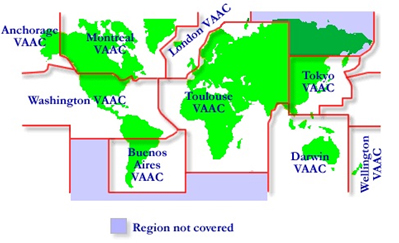Coping with volcanic ash clouds
Based on the seriousness of volcanic ash hazard the ICAO (International Civil Aviation Organization) established the International Airways Volcano Watch Organization (IAVW) which includes 9 different Volcanic Ash Advisory Centers.
During the event in April 2010 the ash advisory center (VAAC) in London was responsible for monitoring and forecasting the movement of the volcanic ash cloud over the United Kingdom, Iceland and the north-eastern part of the North Atlantic Ocean. Although this is a relatively small area, it covers some of the busiest airways in the world. When a volcano in its area of responsibility erupts, the VAAC, runs the NAME atmospheric dispersion model.
A volcanic eruption on Iceland can quickly affect a large area of airspace, as strong winds spreading the ash downwind from the volcano. Air traffic control organisations need to react quickly to the forecasts issued by the VAAC so that aircraft can be diverted onto alternative safe tracks. Like the London VAAC the Toulouse VAAC follows the same main mission. Based on the reports provided by the VAAC centers, the European Organization for the safety of Air Navigation (EUROCONTROL) can release further recommendations.
However it is up to the national aviation control centers to decide which protective actions should be taken. Since current technologies cannot provide a fully reliable representation of ash concentrations, the decision concerning further actions is extremely challenging.
It should at least be noted that whatever the direction of this decision, once the volcanic is encountered the damage can be enormous.
